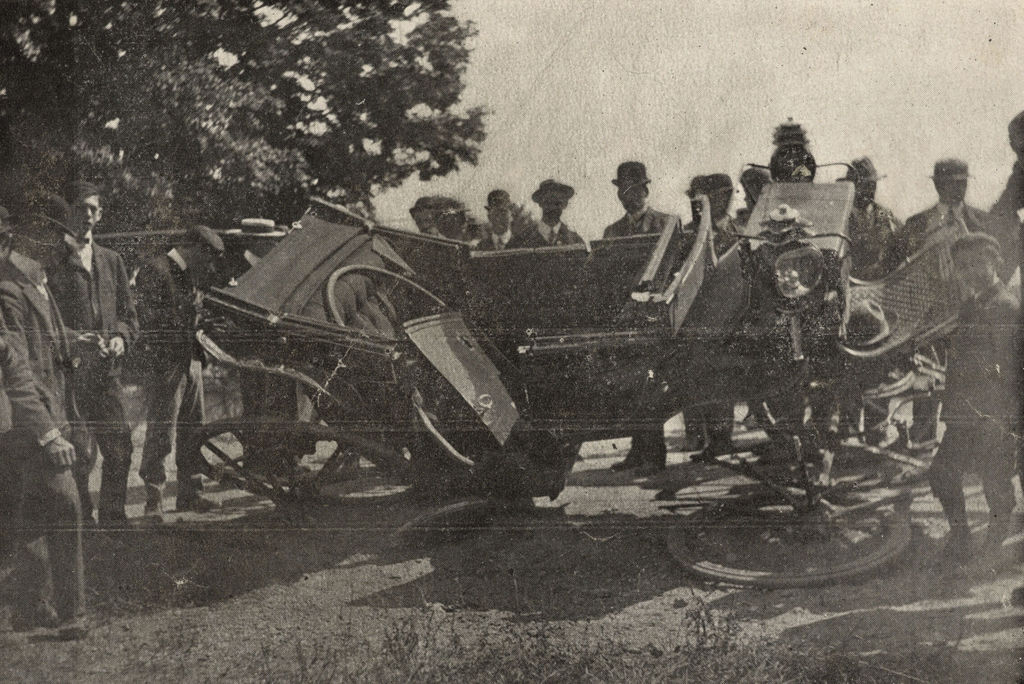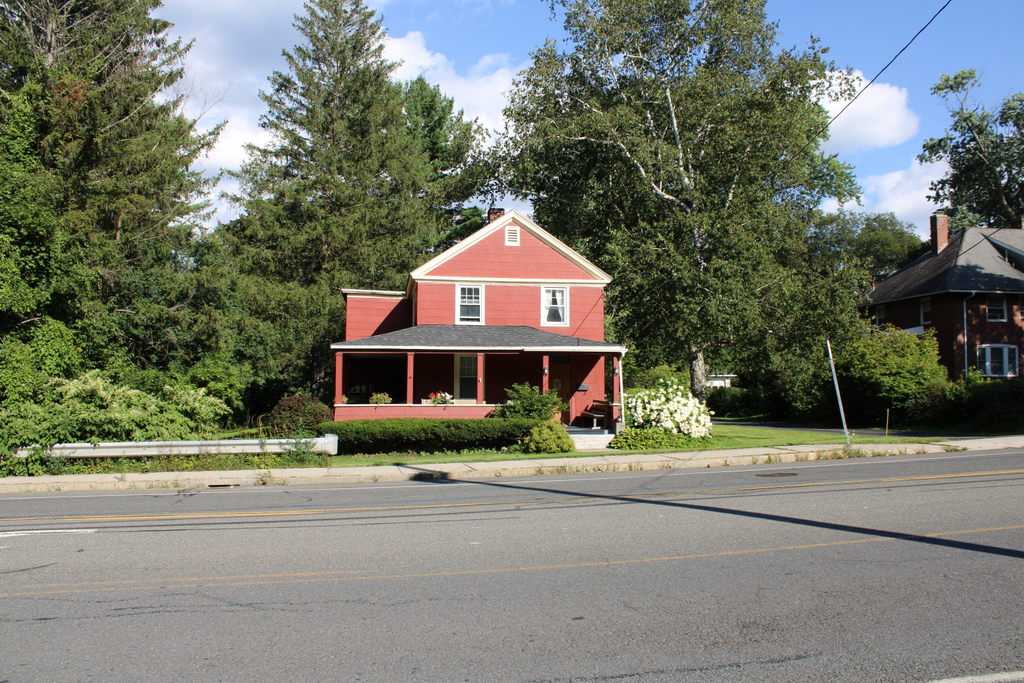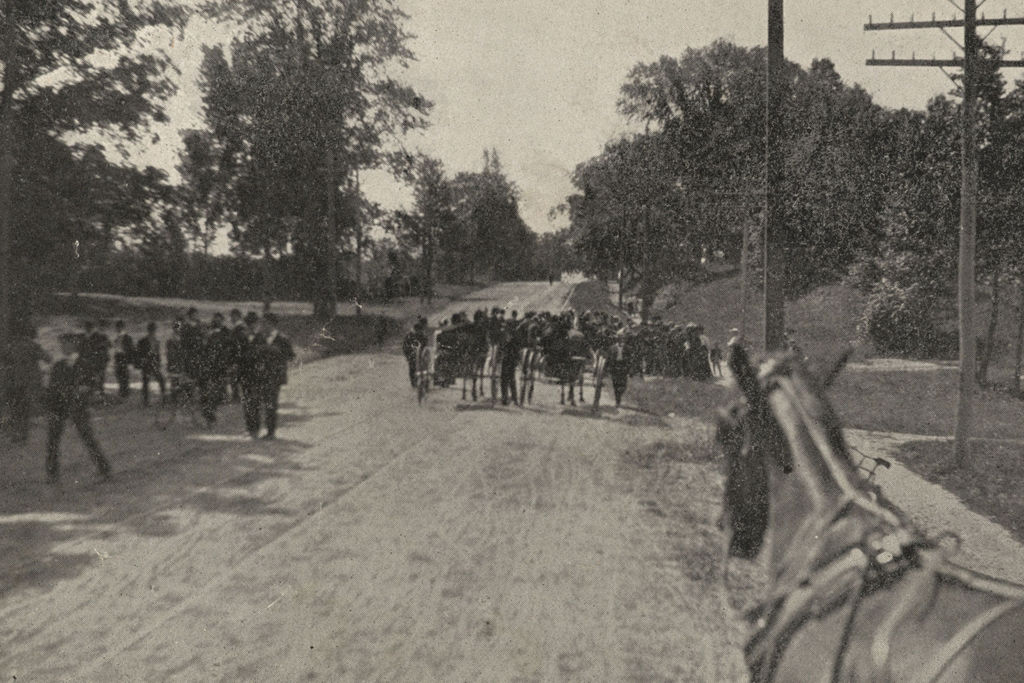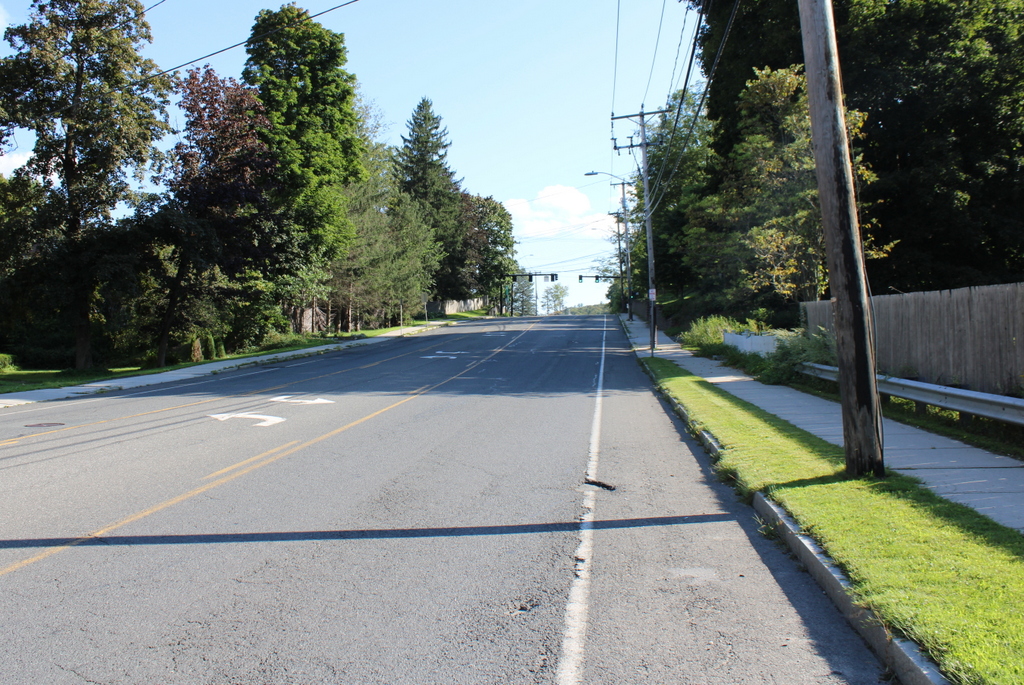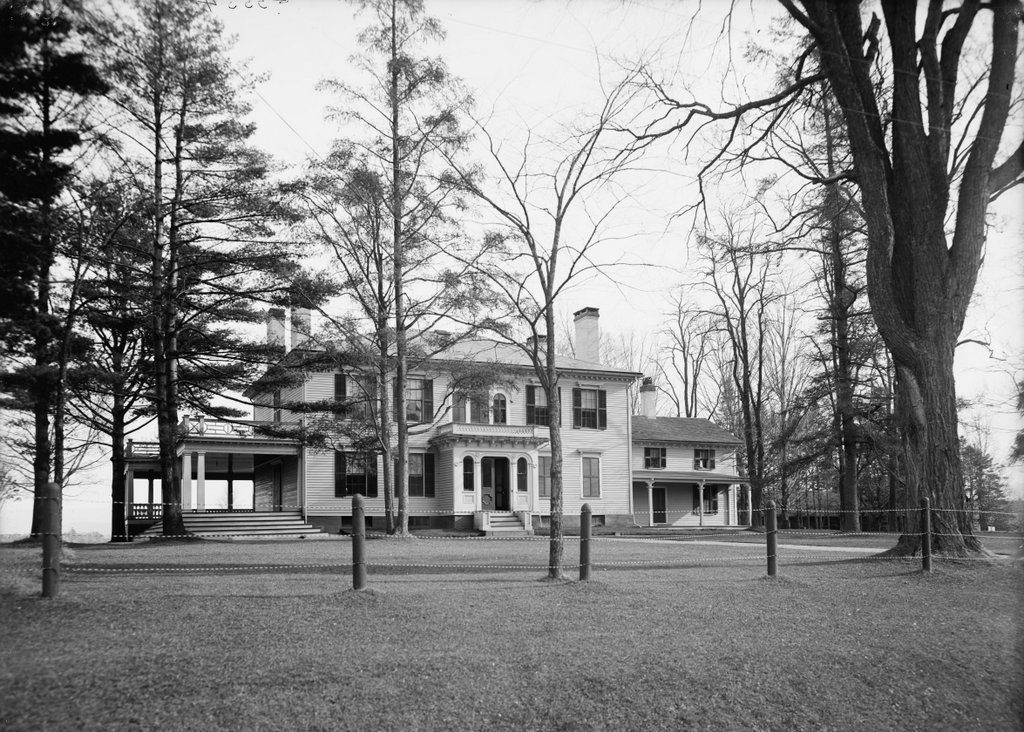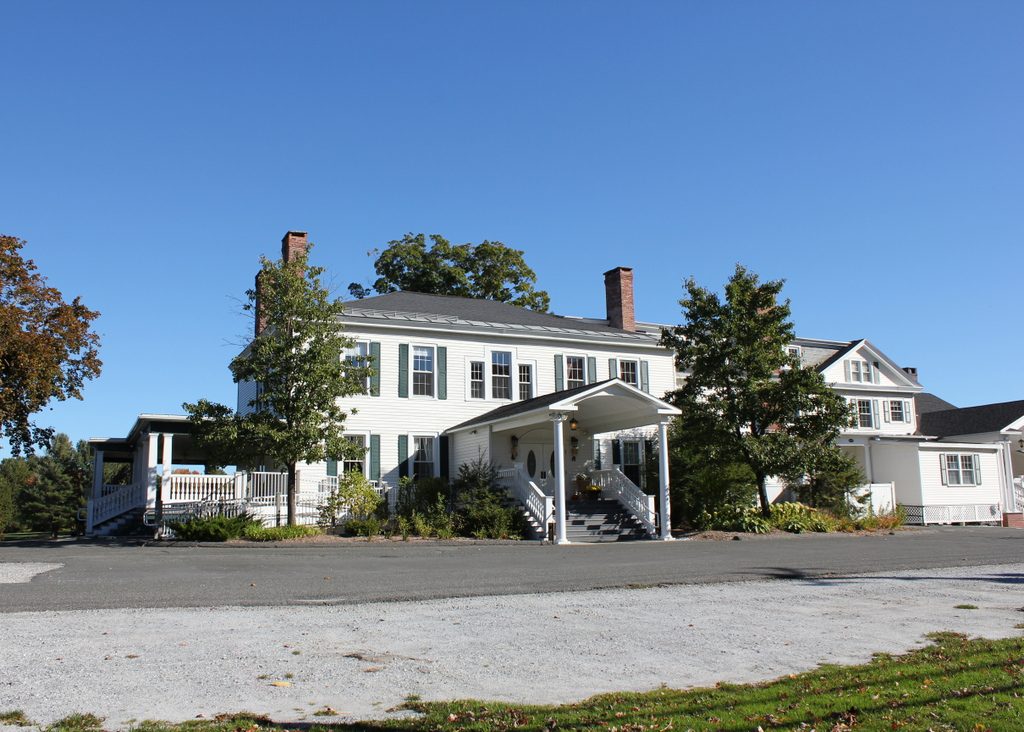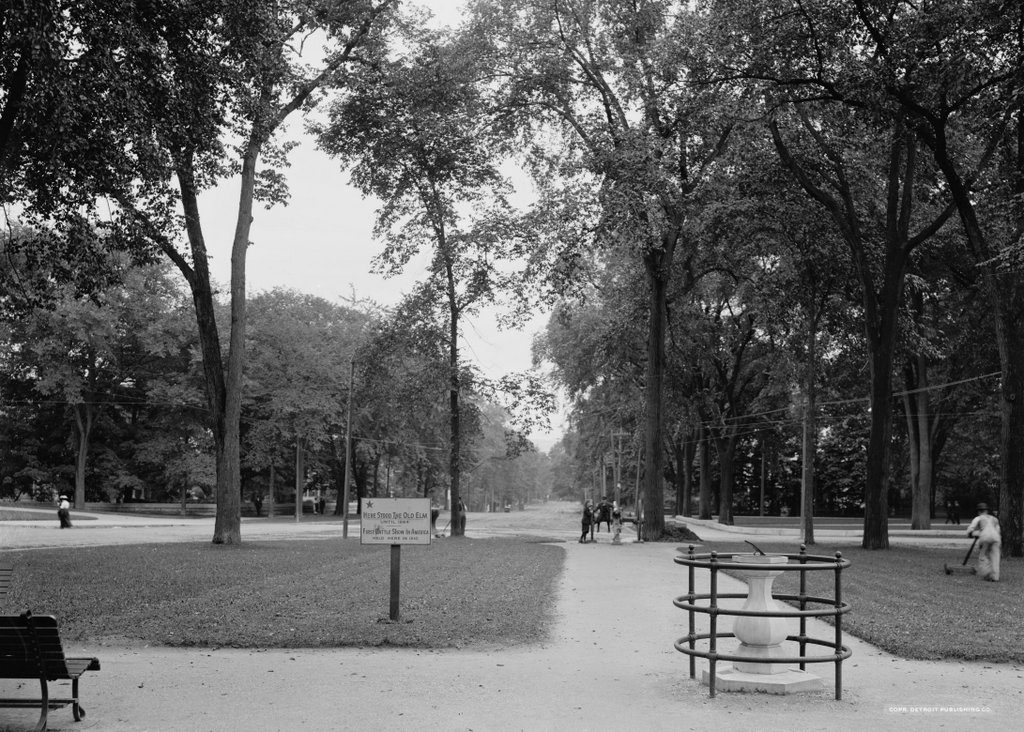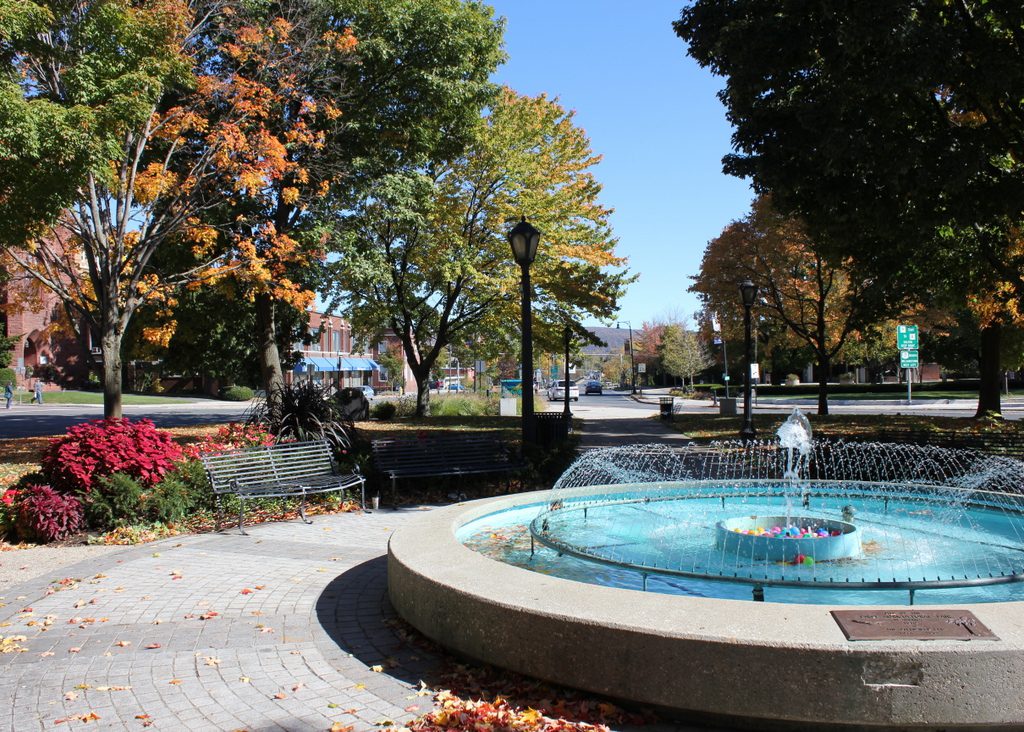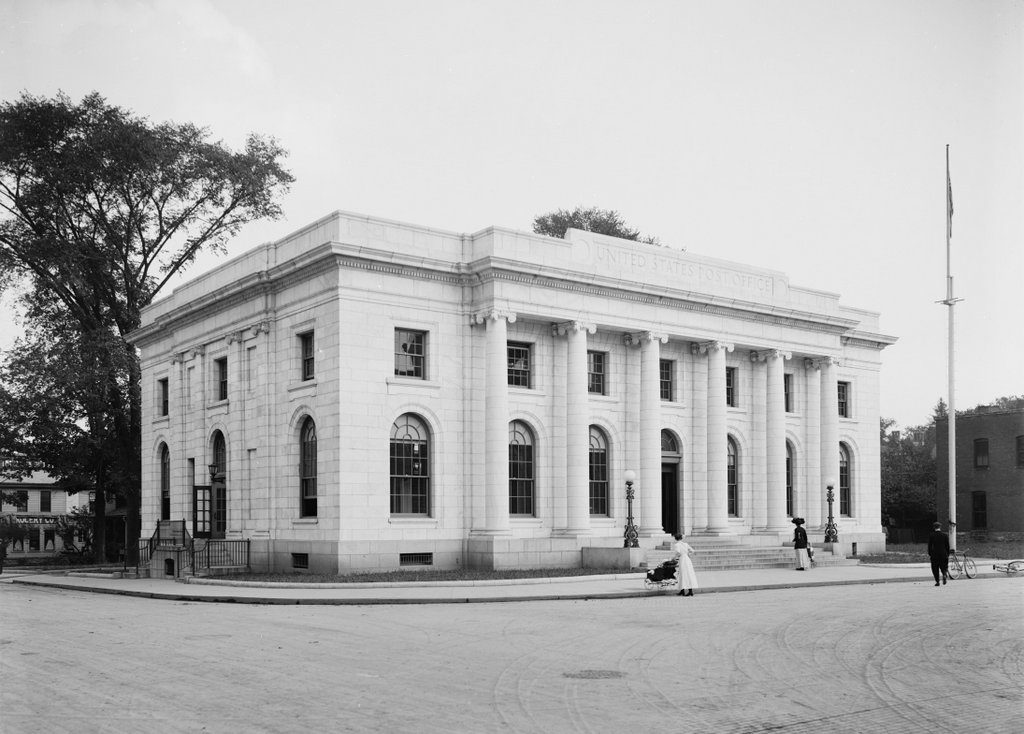The scene of an accident involving President Theodore Roosevelt’s horse-drawn carriage and an electric trolley, on South Street near Wampenum Brook, on September 3, 1902. Image courtesy of the Harvard Library, Theodore Roosevelt Collection.

The scene in 2023:
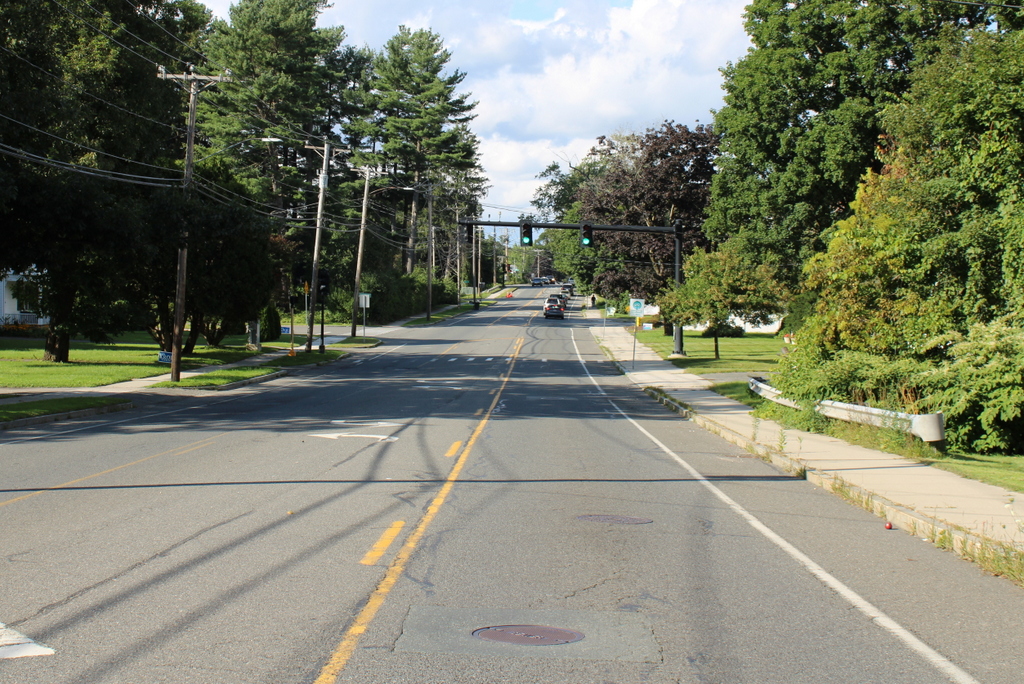
These two photos show the spot in Pittsfield where Theodore Roosevelt was nearly killed when a trolley collided with his carriage while he was traveling through Pittsfield during a speaking tour across New England. Although he survived the accident, his Secret Service bodyguard was killed, making it the first time that a Secret Service agent was killed in the line of duty while protecting the president. Roosevelt himself suffered a leg injury that developed into a life-threatening infection. His leg never fully healed, and the injury may have ultimately been a contributing factor in his death 17 years later.
The accident occurred on the last day of a two-week trip across New England. Roosevelt had been president for just under a year at this point, having become president after William McKinley’s assassination in September 1901. His New England tour involved campaigning for various Republican congressional candidates, in an effort to maintain Republican control of the House and Senate. Over the course of the two weeks, Roosevelt traveled through Connecticut, Rhode Island, eastern Massachusetts, Maine, New Hampshire, and Vermont. He spent all day on September 2 traveling throughout central and western Massachusetts, including stops in Millers Falls, Orange, Athol, Fitchburg, Leominster, Worcester, Springfield, and Westfield, before spending the night in Dalton at the home of Governor Winthrop Murray Crane.
The next day, September 3, Roosevelt gave a speech at the town hall in Dalton. He then traveled to Pittsfield, gave a speech at Park Square, and then visited former U.S. Senator Henry L. Dawes at his house on Elm Street. From there, he continued south on his way to Lenox, and the route was to include a brief stop at the Pittsfield Country Club. Roosevelt traveled in a four-horse landau that driven by David J. Pratt, a coachman and livery stable owner from Dalton. Along with the president, the carriage also included Governor Crane, Roosevelt’s aide George Cortelyou, and his Secret Service bodyguard, William Craig.
Also traveling south on South Street was car 29 of the Pittsfield Street Railway, which was being operated despite an earlier agreement with the mayor to suspend trolley service while the president was in Pittsfield. It had a large number of passengers who were apparently hoping to see the president speak at the country club, and its crew consisted of conductor James T. Kelly and motorman Euclid Madden.
About a mile south of Park Square, South Street crosses a bridge over railroad tracks. From there, the road goes downhill for about a quarter mile to a culvert over the Wampenum Brook, before beginning an incline toward the country club. Back in 1902, the trolleys ran on South Street along a single track that was generally in the center of the roadway. However, the roadway narrowed just beyond the culvert, and the tracks shifted over from the center to the west side of the road. This meant that southbound vehicles driving on the right side of the tracks would run out of room once they got across the culvert, and would have to cross over the tracks at an oblique angle in order to continue southward.
This is what David Pratt did as he was driving the president’s carriage along South Street at around 9:45 a.m. However, just as he was starting the turn, trolley car 29 was approaching this same spot. Exactly how fast motorman Madden was traveling was later subject to much debate, but he was unable to stop in time, and struck the front left wheel of the carriage, along with the horse that was directly in front of it. The impact threw both Pratt and Secret Service agent William Craig from their elevated positions on the box, and the trolley dragged the carriage and horses for about 40 feet before it came to a stop.
In a subsequent newspaper article published on September 5, 1902, Governor Crane’s secretary John B. Smith provided a description of the accident. He had been traveling in another carriage behind the president’s, and he observed:
I was riding with my back to the horses. As we moved along the electric car passed, or rather whizzed, by. My judgment was that it went at a speed of about 20 miles an hour. I then made some remark about the speed of the car to those in the carriage with me. Suddenly our carriage came to a halt. The stop was so quick that I thought something was wrong, and I immediately stood in my place and looked ahead. I quickly saw that something had indeed happened.
I have read in some newspapers of shrieks and cries that greeted the collision. As a matter of fact there was not a shriek. On the contrary, the silence was awful and appalling. People looked at one another, but said not a word, nor was a cry raised. The terrible feeling that the president of the nation was in that wreck seemed to silence everybody.
Of course, in less time than it takes to tell it we had left our carriage and gone forward. At first it appeared that there was a perfect mass of men entangled in the wreck. As I approached the scene I saw the governor rise. One look at his face and I knew that he was unhurt. Then the president appeared. He, too, was apparently unscathed, but a bit dazed. For a moment he seemed clearly angry and indignant. He quickly conquered and controled himself. In fact, he acted admirably throughout the whole trying situation and after.
Although Roosevelt and Crane were able to walk away from the accident, William Craig was killed instantly. After being thrown from the carriage, the trolley wheels passed directly over him. Pratt, the carriage driver, was badly hurt when the injured horse fell on top of him. He suffered a dislocated shoulder, a sprained ankle, and cuts to his face, and the initial news reports incorrectly stated that he was not expected to survive.
As Smith described, Roosevelt’s initial response was anger, upon seeing that Craig had been killed. The two men had been friends, with Craig having served as his bodyguard for a year after Roosevelt became president. He directed his anger toward the motorman, Euclid Madden. According to the next day’s Boston Globe coverage, Roosevelt told him:
This is the most damnable outrage I ever knew. If you lost control of your car, there is some excuse, but if you tried to pass us, disregarding all our warnings, you ought to be punished.
Other accounts add that Roosevelt shook his fist while saying this, and then questioned Madden about why he was operating the trolley in such a manner, to which Madden supposedly protested that he had the right of way.
Following this confrontation, the president and his party went to the home of Maroa Stevens, a 53-year-old widow who lived at 539 South Street, directly across from the scene of the accident. There, Roosevelt’s surgeon Dr. Lung treated his injuries, which included a cut on his lower lip, bruising and swelling on his face, and a black eye. He also bruised his left shin, although it took time to realize the seriousness of this particular injury. Dr. Lung also treated George Cortelyou here, who was hit in the back of the head during the accident. They spent about a half hour resting and recuperating here, and in the meantime Craig’s body was removed, Pratt was transported to the hospital, the injured horse was euthanized, and a new carriage was obtained for the president.
The top photo was taken in the immediate aftermath of the accident, facing north up South Street. On the far left side is the president’s carriage, and in the center of the scene is car 29, the trolley that was involved in the accident. It appears to have been moved backwards away from the site of the accident by the time the photo was taken. Just out of view on the far right side is the Stevens house. It seems unclear whether Roosevelt was still here when the photo was taken, or if he had already continued southward.
Roosevelt made brief appearances at his scheduled stops for the remainder of the day, but these tended to have a somber tone, given the circumstances of Craig’s death. At Lenox he spoke to a crowd in front of the Curtis Hotel, telling them:
We have met with an accident. One of our party, a faithful friend, has been killed. He was the most faithful man I ever knew, and my children fairly worshiped him. Our driver is undoubtedly fatally injured. Under the circumstances, it is, of course, impossible for me to say more to you than that I deeply appreciate your kindly greetings. I ask that you not cheer or applaud.
He made similar stops in Stockbridge and Great Barrington, and then in New Milford and Bridgeport, Connecticut, before boarding his yacht in the evening and sailing back to his home in Oyster Bay. Over the next few weeks, he would downplay the seriousness of his own injuries, including a speech on September 15 when he reassured his listeners that “it takes more than a trolley car accident to knock me out, and more than a crowd to tire me.” However, the reality was that his shin was becoming dangerously infected, leading to an emergency surgery while on the campaign trail in Indianapolis on September 23. The procedure involved draining an abscess, and it was extremely painful for Roosevelt, who chose to not have anesthesia. He made it through, but the infection ended up returning, and he needed a second operation on September 28. This time, Roosevelt’s pain was eased by some whiskey and cocaine.
The president was in a wheelchair for the next few weeks, but the leg never really fully healed, and it would remain a chronic issue for him for the rest of his life. In fact, it may have ended up being a contributing factor in his death in 1919, which is believed to have been from a pulmonary embolism. Given Roosevelt’s adventure-seeking lifestyle and his general disregard for his personal health, it’s obviously hard to pin down exactly what may have led to his relatively early death at the age of 60, but it is certainly plausible that the nagging injury from the trolley accident may have played a role in it.
In the meantime, both the conductor and motorman were arrested after the accident and charged with manslaughter. They would both eventually be indicted and plead guilty, but in the end only Madden was prosecuted and sentenced for it. His statement, which he gave on the day of his arrest, tells his version of the accident:
We were going down the hill not faster than eight miles an hour. I had the power off and the brake was on a bit to hold the car in check, as there were lots of teams and a big crowd at the foot of the hill. I was not watching any particular carriage, but was keeping my eye out for all. When we were about 10 feet behind the president’s carriage, Mr. Pratt suddenly swung his horses across the track. I reversed the power but could not stop the car in time to prevent the accident. When the car struck the wheel horse and the carriage, Mr. Craig fell, right off the seat in front of the car. I did not see David J. Pratt at all, and I do not think that anyone in the carriage fell out, as near as I could see. After the car struck the carriage it was pushed about the length of a car and a half. I have been on the Pittsfield road just a year, and until two weeks ago was on the Pontoosuc division when I was transferred to the Country club route. I have lived in Pittsfield nearly all my life, and my home is now at 117 Alder street, where my wife and five children live.
One of the rumors that soon began circulating was that Madden was being pressured by the people on the trolley to speed up, so that they could arrive at the country club in time for the president’s brief stop. Many witnesses did state that the trolley was going at a high rate of speed, including the governor’s secretary who, as quoted earlier, estimated the speed as 20 miles an hour. But Madden denied hearing anyone instructing him to go faster, and stated that even if he had heard them, he would not have done so.
Interestingly, the street railway company gave their full support to their employees. Their lawyer represented them in court, and neither were terminated. Kelly was back on the job the day after his release, and Madden, who ended up spending six months in jail, received his full salary throughout his incarceration and was subsequently reinstated at the end of his sentence. This, of course, raises questions about why the company was so supportive of them. Were they fiercely loyal to their employees? Or, as the rumors alleged, had he been pressured by company officials on the trolley to travel at an unsafe speed, in order to arrive at the country club before the president? Did they make a deal with Madden to have his back as long as he kept his mouth shut? It’s hard to say for sure, but it certainly seems plausible.
The accident also raises a number of hypothetical what-if scenarios. Had the timing of the accident been off by just a few seconds, or if Roosevelt had been sitting in a different part of the carriage, it is entirely possible that he, rather than Craig, could have been crushed beneath the wheels of the trolley. Likewise, his infected leg could very well have resulted in his death, if not for the two successful operations. Because Roosevelt had been vice president before succeeding to the presidency after McKinley’s assassination, and because there was no method for appointing a new vice president at the time, the next in line for the presidency would have been Secretary of State John Hay. Roosevelt considered this possibility ahead of his first surgery, and spoke to his Secretary of War, Elihu Root about becoming Secretary of State, since he did not think that Hay would be up for the task of the presidency. However, because Root was neither appointed nor confirmed as Secretary of State, it seems unclear how this would have played out if Roosevelt had died on the operating table.
In the long run, an untimely Roosevelt death from this accident would have far-reaching implications throughout the 20th century and beyond. Not only would it have meant a different foreign policy rather than Roosevelt’s imperialism, but it also would have meant that he would not have been around to play the spoiler in the 1912 election, which may have meant no Woodrow Wilson during World War I. This would have meant a different American approach to the war, which in turn would have potentially changed the timing and outcome of the war. Which of course would also affect World War II, the Cold War, and many other aspects of world history.
But, hypothetical scenarios aside, here in Pittsfield the city seems to have been eager to move on and forget about the time that they almost killed the president. But, for Euclid Madden, it was not so easy to escape his notoriety from the accident. He remained in Pittsfield for the rest of his life, working for the street railway and later for General Electric, and he died in 1931 at the age of 69. And, of course, his role in the accident would follow him to the end. His death earned him a lengthy obituary in the Berkshire County Eagle, but almost the entire article was focused on the accident that he had been involved in nearly 30 years earlier.
Here on South Street, there are no historical markers or any other indications of what occurred on this site in 1902, and the street itself looks very different from its appearance in the top photo. The narrowness of the old dirt road had been a contributing factor in the accident, but this is no longer an issue, with two paved travel lanes and a center turn lane. The trolley tracks that once ran down the middle of the road are long gone, and even the culvert, which had played a central role in the accident, is now barely noticeable except for the guardrails on the side of the road. Probably the single most significant surviving landmark from the accident is the Stevens house, where Roosevelt received first aid. It still stands on the right side, although it is not visible from this angle.
The text of this article is based on Episode 9: Damnable Outrage from my Western Mass History podcast. For more information about the accident, check out the episode, or listen to my other episodes about the history of Western Massachusetts.
For more then-and-now images of the accident scene, see the posts here and here.

